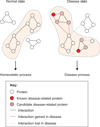Protein-protein interaction networks: probing disease mechanisms using model systems
- PMID: 23635424
- PMCID: PMC3706760
- DOI: 10.1186/gm441
Protein-protein interaction networks: probing disease mechanisms using model systems
Abstract
Protein-protein interactions (PPIs) and multi-protein complexes perform central roles in the cellular systems of all living organisms. In humans, disruptions of the normal patterns of PPIs and protein complexes can be causative or indicative of a disease state. Recent developments in the biological applications of mass spectrometry (MS)-based proteomics have expanded the horizon for the application of systematic large-scale mapping of physical interactions to probe disease mechanisms. In this review, we examine the application of MS-based approaches for the experimental analysis of PPI networks and protein complexes, focusing on the different model systems (including human cells) used to study the molecular basis of common diseases such as cancer, cardiomyopathies, diabetes, microbial infections, and genetic and neurodegenerative disorders.
Figures


Similar articles
-
Application of mass spectrometry based proteomics to understand diabetes: A special focus on interactomics.Biochim Biophys Acta Proteins Proteom. 2020 Oct;1868(10):140469. doi: 10.1016/j.bbapap.2020.140469. Epub 2020 Jun 15. Biochim Biophys Acta Proteins Proteom. 2020. PMID: 32554214 Review.
-
Reconstructing genome-wide protein-protein interaction networks using multiple strategies with homologous mapping.PLoS One. 2015 Jan 20;10(1):e0116347. doi: 10.1371/journal.pone.0116347. eCollection 2015. PLoS One. 2015. PMID: 25602759 Free PMC article.
-
A homologous mapping method for three-dimensional reconstruction of protein networks reveals disease-associated mutations.BMC Syst Biol. 2018 Mar 19;12(Suppl 2):13. doi: 10.1186/s12918-018-0537-2. BMC Syst Biol. 2018. PMID: 29560828 Free PMC article.
-
Simultaneous quantification of Cyt c interactions with HSP27 and Bcl-xL using molecularly imprinted polymers (MIPs) coupled with liquid chromatography-tandem mass spectrometry (LC-MS/MS)-based targeted proteomics.J Proteomics. 2019 Feb 10;192:188-195. doi: 10.1016/j.jprot.2018.09.001. Epub 2018 Sep 17. J Proteomics. 2019. PMID: 30237093
-
From classical to new generation approaches: An excursus of -omics methods for investigation of protein-protein interaction networks.J Proteomics. 2021 Jan 6;230:103990. doi: 10.1016/j.jprot.2020.103990. Epub 2020 Sep 20. J Proteomics. 2021. PMID: 32961344 Review.
Cited by
-
A polygenic risk score model for psoriasis based on the protein interactions of psoriasis susceptibility loci.Front Genet. 2024 Nov 6;15:1451679. doi: 10.3389/fgene.2024.1451679. eCollection 2024. Front Genet. 2024. PMID: 39568675 Free PMC article.
-
Protein-protein and protein-nucleic acid binding site prediction via interpretable hierarchical geometric deep learning.Gigascience. 2024 Jan 2;13:giae080. doi: 10.1093/gigascience/giae080. Gigascience. 2024. PMID: 39484977 Free PMC article.
-
SPOT: spatial proteomics through on-site tissue-protein-labeling.Clin Proteomics. 2024 Oct 24;21(1):60. doi: 10.1186/s12014-024-09505-5. Clin Proteomics. 2024. PMID: 39443867 Free PMC article.
-
Biofunctionalized dissolvable hydrogel microbeads enable efficient characterization of native protein complexes.Nat Commun. 2024 Oct 5;15(1):8633. doi: 10.1038/s41467-024-52948-5. Nat Commun. 2024. PMID: 39366952 Free PMC article.
-
Pair-EGRET: enhancing the prediction of protein-protein interaction sites through graph attention networks and protein language models.Bioinformatics. 2024 Oct 1;40(10):btae588. doi: 10.1093/bioinformatics/btae588. Bioinformatics. 2024. PMID: 39360982 Free PMC article.
References
-
- Venkatesan K, Rual JF, Vazquez A, Stelzl U, Lemmens I, Hirozane-Kishikawa T, Hao T, Zenkner M, Xin X, Goh KI, Yildirim MA, Simonis N, Heinzmann K, Gebreab F, Sahalie JM, Cevik S, Simon C, de Smet AS, Dann E, Smolyar A, Vinayagam A, Yu H, Szeto D, Borick H, Dricot A, Klitgord N, Murray RR, Lin C, Lalowski M, Timm J. et al.An empirical framework for binary interactome mapping. Nat Methods. 2009;6:83–90. doi: 10.1038/nmeth.1280. - DOI - PMC - PubMed
Publication types
LinkOut - more resources
Full Text Sources
Other Literature Sources


